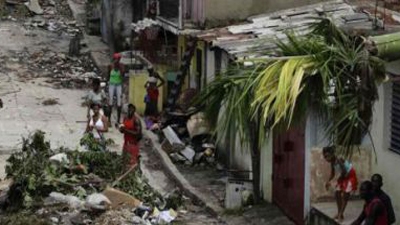Arthur, the first hurricane of 2014, will hit the eastern seaboard of the United States in a matter of days. With winds of up to 100 kilometers per hour and an expected path stretching from Florida to Massachusetts, the storm is part of a new generation of hurricanes that are nourished by and move across oceans whose levels have increased 3.2 mm annually for the past 20 years (double the rate of the previous 80 years).
When it has completed its course, towards the end of the week, Arthur and the damage it cause will be tallied with the figures recorded for these natural disasters over the past 20 years: damages of US$ 212 billion, almost double the GDP of all Caribbean countries combined, for example.
While meteorologists are predicting a less active hurricane season than in the past, what is certain is that the ones that do occur will have the greatest impact on the small islands of the Caribbean, a region already disproportionately affected by floods and earthquakes.
For this part of the world, where seven of every 10 people live near the coast —and with almost all of their largest cities within 1.5 kilometers of the sea—, it is imperative to develop a regional defense strategy to face this threat.
Additionally, the islands are highly vulnerable to the effects of climate change. It is still not known exactly what the impact of an average global temperature increase will be on the storm cycle, but experts agree that the Caribbean will get the worst of it.
“It is a gray area; there is still no evidence of an increase in intensity or number of storms,” says Jerry Meier, a World Bank climate change expert. “But the sea level is undeniably rising.”
Although it is currently impossible to prevent hurricanes from making landfall in the Caribbean, countries can take measures to impede the storm from becoming a catastrophe once it reaches the coast, or at least to reduce its impact.
“Every country can reduce its vulnerability,” says Remi Trier, a World Bank water and sanitation expert. “Anticipating the dangers and assessing vulnerabilities of the population and infrastructure are crucial for disaster risk management.”
It is a warning that most Caribbean countries have taken very seriously.
The poor, the most affected
In 1979, Hurricane David left 2,000 people dead and over US$ 2.6 million in damages in the Dominican Republic alone. Following this and similar events, most Caribbean countries now have programs to manage the risks associated with the natural disasters they face every year. Programs for improved risk management of cities are especially noteworthy.
These disasters clearly have the greatest impact on the poorest citizens. When Hurricane Noel hit the Dominican Republic in 2007, 90 percent of those directly affected lived below the poverty line.
“The negative effects of natural disasters are not limited to the short term,” said Trier. “They can push households into poverty, from which they cannot escape without outside help.”
In a region where between 14% (Bahamas) and 65% (Haiti) of the population lives in poverty, with precarious housing or in locations with inadequate infrastructure, communities have fewer resources to protect themselves in the event of hurricanes or storms and the flooding they produce.
The situation is worrying for families as well as countries. In Jamaica, for example, it is estimated that 96% of GDP is threatened by two or more natural disaster risks. Not only is there a danger from hurricanes, but also from the country’s 120 rivers and creeks, which increase the risk of flooding after a tropical storm.
In 2007, 16 Caribbean countries formed a common fund to confront disaster risks and mitigate the economic effects of a natural disaster. It is a type of collective insurance that represents a paradigm shift for the region in terms of confronting the risk and being prepared for natural disasters.

